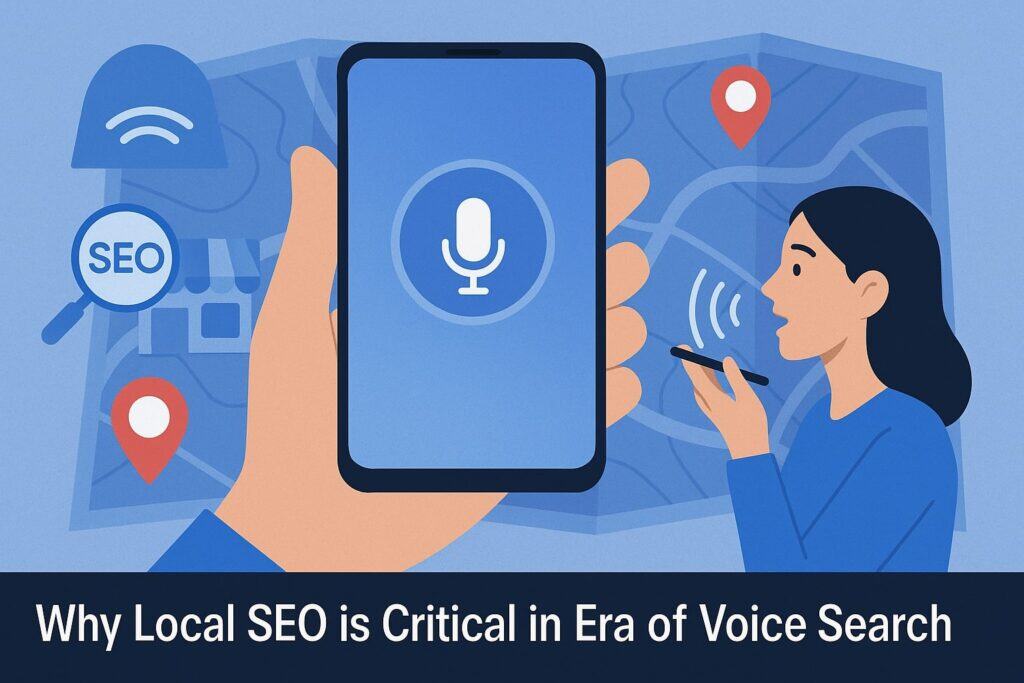
Voice Search and Local SEO: Preparing Your Business
The rapid growth of voice-enabled technologies has changed how consumers search for products, services, and local businesses. With the rise of digital assistants like Siri, Alexa, and Google Assistant, businesses can no longer rely solely on traditional SEO strategies.
Instead, voice search optimization, combined with a strong local SEO foundation, has become a necessity. Preparing your business for this transformation requires understanding user behavior, adapting content for conversational search, and ensuring your business information is accurate and accessible across all platforms.
In this guide, we’ll explore the impact of voice search on local SEO, why it matters for small and medium-sized businesses, and how to prepare your website and online presence for the next generation of search queries.
The Rise of Voice Search in Consumer Behavior

Voice search adoption is one of the fastest-growing trends in digital marketing. Studies suggest that nearly half of all online searches are now voice-based, and this number is projected to increase as smart speakers and mobile voice assistants become even more integrated into daily life.
Consumers are finding voice search convenient because it saves time, feels natural, and can be done while multitasking.
One of the most important aspects of voice search is its conversational nature. Instead of typing short, keyword-heavy queries such as “best pizza NYC,” users ask full questions like “Where can I find the best pizza near me right now?”
This difference changes the way businesses must approach search optimization. Content needs to be aligned with natural speech patterns and long-tail queries.
Local businesses, in particular, have the most to gain from voice search optimization. Voice searches are often intent-driven, meaning that users are closer to making a purchasing decision.
A user asking their phone, “What’s the closest coffee shop open now?” is signaling strong buying intent. If your business is not optimized for voice search, you risk losing valuable leads to competitors who are more prepared.
Furthermore, voice search is also driving more reliance on mobile devices and “near me” searches. Google has reported exponential growth in searches like “near me,” “open now,” and “best near me.”
These patterns show that consumers want fast, reliable answers, and businesses must ensure their digital presence delivers. Another factor contributing to voice search growth is the improvement in artificial intelligence and natural language processing.
Today’s voice assistants can understand accents, context, and even follow-up questions with far more accuracy than in the past. This advancement has increased user trust, making voice search an everyday habit for many.
For businesses, this means a shift in strategy. Traditional SEO focused heavily on desktop searches and text-based keywords.
Voice search demands optimization for conversational phrases, user intent, and highly localized results. Ignoring this trend could leave businesses behind as more consumers rely on voice for decision-making.
In short, the rise of voice search reflects a broader trend in consumer behavior: the demand for faster, easier, and more relevant answers. Businesses that adapt early will not only gain visibility but also build stronger trust with their audience.
Why Local SEO is Critical in the Era of Voice Search

Local SEO is the foundation of successful voice search optimization. When users perform voice searches, a large portion of them are location-based. Phrases like “near me,” “closest,” or “in [city]” dominate voice queries.
Therefore, if your local business information is not accurate and optimized, you could be missing out on a huge share of traffic and customers.
Local SEO ensures that your business shows up in search engine results, map listings, and voice search responses when consumers are nearby. At the core of local SEO is the concept of “NAP consistency” – Name, Address, and Phone Number.
Your business information must be consistent across Google Business Profile, directories, social media, and your website. Even small discrepancies can confuse search engines and lower your chances of appearing in local results.
Google’s algorithm prioritizes businesses that are relevant, close in proximity, and trustworthy. When someone uses voice search to ask, “What’s the best Italian restaurant near me?”
Google Assistant or Siri doesn’t show dozens of links—it provides a few highly relevant results. That means your business has only one shot at being included in that shortlist.
Reviews and ratings also play a critical role. Voice search algorithms often pull data from review platforms like Google, Yelp, and TripAdvisor.
If your business has a high rating and consistent positive reviews, it’s more likely to appear in voice search answers. Local SEO strategies must therefore include a strong reputation management system.
Another critical factor is mobile optimization. Since most voice searches are performed on mobile devices, your website must be mobile-friendly, fast, and easy to navigate. If a customer clicks through after a voice search result but finds a slow-loading or poorly designed site, they are likely to bounce and try a competitor instead.
Schema markup is another local SEO strategy that supports voice search optimization. By adding structured data to your website, you help search engines understand your content better. For example, marking up business hours, services, and reviews makes it easier for voice assistants to deliver accurate information to users.
In summary, local SEO is not optional for businesses preparing for the era of voice search. It ensures visibility, builds trust, and connects your brand with nearby customers who are ready to buy.
By focusing on accurate business listings, strong reviews, mobile optimization, and structured data, you create a foundation that makes your business voice-search-ready.
Optimizing Your Website for Voice Search Queries

Voice search optimization requires rethinking how content is created and structured on your website. Unlike traditional search engine optimization, which often focuses on keywords and backlinks, voice search emphasizes natural language and intent. To succeed, your website must answer the kinds of questions people ask aloud.
First, focus on conversational keywords. Instead of optimizing only for short-tail phrases like “plumber Chicago,” include longer, question-based keywords such as “Who is the best plumber in Chicago for emergency services?”
Creating FAQ pages, blog posts, and service pages that directly answer these types of questions increases your chances of ranking in voice search results.
Second, prioritize featured snippets and “position zero” rankings. Voice assistants often read out the content from featured snippets when answering queries. To target this, structure your content in a clear, concise manner.
Use bullet points, numbered lists, and direct answers to common questions. For example, if you own a dental clinic, create content that directly answers “What’s the best way to relieve tooth pain at home?”
Third, improve page speed and technical SEO. Voice search users expect instant answers, and search engines reward fast websites with better visibility. Compress images, use a reliable hosting service, and enable caching to reduce load times. Google’s Core Web Vitals should be part of your technical SEO checklist.
Fourth, implement structured data markup. Adding schema for your business type, location, reviews, and events gives search engines the context they need to display your information in rich results. Voice assistants rely on this structured data to provide accurate answers.
Fifth, optimize for mobile and local intent. Voice search is heavily mobile-driven, so ensure your site is responsive and easy to navigate on small screens. Include “click-to-call” buttons, interactive maps, and location-based landing pages.
Finally, don’t forget about content tone and readability. Since voice searches are conversational, your website content should reflect that natural flow.
Write in a way that mirrors how people speak. Short, clear sentences with a friendly, informative tone perform best. Avoid excessive jargon and keep the focus on user intent.
By making these adjustments, your website becomes more aligned with how people use voice search. Instead of just targeting keywords, you’re targeting human conversation. This not only improves visibility in search but also enhances the overall user experience.
Key Strategies to Dominate Local SEO and Voice Search
To stand out in voice and local search, businesses must go beyond basic SEO and adopt strategies tailored for the voice-first world. Below are essential strategies every business should implement.
- Claim and Optimize Your Google Business Profile: Your Google Business Profile (formerly Google My Business) is often the first source voice assistants pull from. Ensure your business information is accurate, add photos, update hours regularly, and encourage reviews.
- Focus on Customer Reviews: Voice assistants heavily rely on reviews when suggesting businesses. Encourage satisfied customers to leave feedback on Google and Yelp. Responding to reviews also shows credibility.
- Use Hyperlocal Content: Create content that ties your business to your community. Blog about local events, highlight nearby landmarks, or create location-specific service pages. This signals to search engines that your business is relevant to local queries.
- Optimize for “Near Me” Searches: Include terms like “near me” and city-specific keywords in your content. While Google can infer location, adding explicit references boosts your chances of ranking.
- Build Local Citations: Ensure your business is listed on local directories such as Yelp, Yellow Pages, and industry-specific platforms. Consistent NAP data across all citations strengthens your local SEO.
- Leverage Structured Data: Schema markup for local businesses, events, services, and reviews helps search engines and voice assistants understand your information better.
- Invest in Fast, Mobile-Friendly Websites: Page speed and usability are critical ranking factors. A seamless mobile experience keeps customers engaged.
- Create FAQ Pages for Voice Queries: Build a robust FAQ section with conversational questions. This increases your chances of being featured in voice search answers.
- Monitor Analytics for Voice Search Performance: Track how users find your business through voice search by using Google Search Console and analytics tools. Look for question-based queries and adjust your content strategy accordingly.
- Stay Updated on Emerging Technology: Voice search is evolving quickly. Stay updated on new features from Google, Amazon, and Apple to ensure your business adapts with the technology.
By implementing these strategies, businesses not only prepare for the future of search but also gain a competitive advantage in their local market. Voice search isn’t a passing trend—it’s a fundamental shift in how people connect with businesses.
FAQs
Q1. Why is voice search important for small businesses?
Answer: Voice search is critical for small businesses because it connects them with customers who are ready to buy. Unlike general searches, voice queries often have high intent.
When someone asks, “Where’s the best plumber near me?” They are actively looking for a service provider in real-time. For small businesses, this is an opportunity to capture leads instantly.
Additionally, voice search levels the playing field. While large corporations can dominate traditional search rankings with huge marketing budgets, local businesses can compete in voice search by maintaining accurate business profiles, generating strong reviews, and optimizing for conversational queries.
Small businesses that focus on hyperlocal SEO stand a strong chance of ranking in voice search results without needing the same level of investment as big brands.
Moreover, voice search integrates with everyday devices like smartphones, smart speakers, and cars. This accessibility makes it easier for customers to find small businesses during daily routines.
A customer could be driving home and ask Siri to “find a florist near me open now.” If your business is optimized, you could be the one they visit.
Q2. How does voice search affect local SEO differently than traditional search?
Answer: Traditional SEO focuses heavily on keywords, backlinks, and desktop searches. Local SEO within the voice search context, however, emphasizes conversational queries and user intent.
Instead of typing “best coffee shop NYC,” users ask, “Where’s the best coffee shop near me right now?” This shift requires businesses to adapt content to natural speech patterns.
Voice search also tends to provide fewer results. On a desktop, Google might show ten blue links. In voice search, assistants typically offer only the top one to three options. That means local SEO becomes more competitive—businesses must ensure their listings, reviews, and site optimization are strong enough to land in those top results.
Another difference is proximity. While traditional search considers location, voice search prioritizes immediate relevance. If a customer is walking downtown and asks Google Assistant, “Find a pizza place nearby,” the assistant will provide results within walking distance, not just general listings.
For businesses, this means accuracy and timeliness matter. Updating your business hours, ensuring correct location details, and highlighting services are crucial for capturing voice-driven traffic.
Conclusion
Voice search and local SEO are no longer optional—they are essential components of a successful digital marketing strategy. Consumers want fast, relevant, and accurate answers, and businesses that meet this demand will thrive.
By understanding the rise of voice search, investing in strong local SEO foundations, and optimizing your website for conversational queries, you position your business to attract more local customers and stay ahead of competitors.
The future of search is voice-driven, mobile-focused, and intent-based. Businesses that act now by updating their Google Business Profile, implementing structured data, focusing on reviews, and creating conversational content will reap long-term rewards.
Whether you’re a small shop owner, a service provider, or a local restaurant, preparing for voice search and local SEO ensures your business remains visible and competitive in an ever-changing digital landscape.